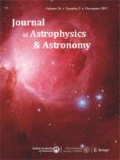Abstract
Most of the known pulsars are sources of highly linearly polarized radiation. Faraday rotation in the intervening medium rotates the plane of the linear polarization as the signals propagate through the medium. The Rotation Measure (RM), which quantifies the amount of such rotation as a function of wavelength, is useful in studying the properties of the medium and in recovering the intrinsic polarization characteristics of the pulsar signal. Conventional methods for polarization measurements use telescopes equipped with dual orthogonally polarized feeds that allow estimation of all 4 Stokes parameters. Some telescopes (such as the Ooty Radio Telescope) that offer high sensitivity for pulsar observations may however be receptive to only a single linear polarization. In such a case, the apparent spectral intensity modulation, resulting from differential Faraday rotation of the linearly polarized signal component within the observing bandwidth, can be exploited to estimate the RM as well as to study the linear polarization properties of the source. In this paper, we present two improved procedures by which these observables can be estimated reliably from the intensity modulation over large bandwidths, particularly at low radio frequencies. We also highlight some other applications where such measurements and procedures would be useful.
Similar content being viewed by others
References
Hamilton, P. A., Lyne, A. 1987,Mon. Not. R. Astr. Soc,224, 1023.
McCulloch, P. M., Hamilton, P. A., Manchester, R. N., Abies, J. G. 1978,Mon. Not. R. Astr. Soc,183, 645.
Radhakrishnan, V., Cooke, D. J., 1969,Astrophys. J. Lett.,3, 225.
Ramkumar, P. S., Prabu, T., Madhu Girimaji, Markendeyulu, G. 1994,J. Astrophys. Astr.,15, 343.
Ramkumar, P. S., Deshpande, A. A. 1994, Proc. of the 16th meeting of Astronomical Society of India, Pune 1995, (ed.) V. K. Kapahi,Bull. Astr. Soc. India,23(4), 475.
Smirnova, T. V., Boriakoff, V. 1997,Astr. Astrophys.,321, 305.
Suleimanova, S. A., Volodin, Yu. V., Shitov, Yu. P. 1988,Sov. Astron.,32(2), 177.
Taylor, J. H., Manchester, R. N., Lyne, A. G. 1993,Astrophys. J. Suppl Ser.,88, 529.
Author information
Authors and Affiliations
Rights and permissions
About this article
Cite this article
Ramkumar, P.S., Deshpande, A.A. Determination of linear polarization and faraday rotation of pulsar signals from spectral intensity modulation. J Astrophys Astron 20, 37–50 (1999). https://doi.org/10.1007/BF02715038
Received:
Accepted:
Issue Date:
DOI: https://doi.org/10.1007/BF02715038




